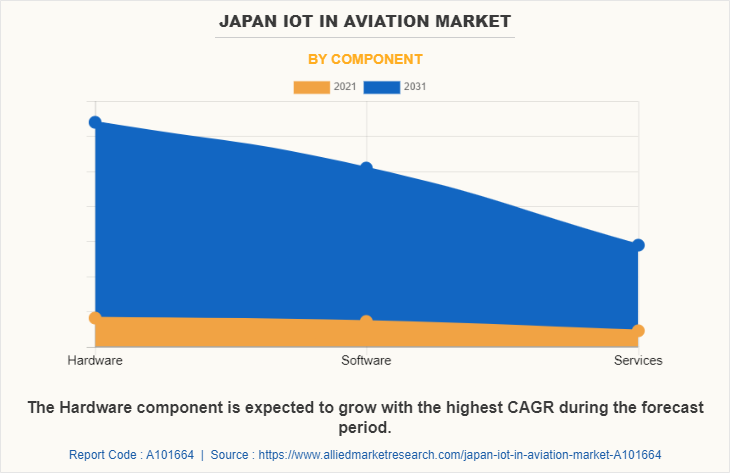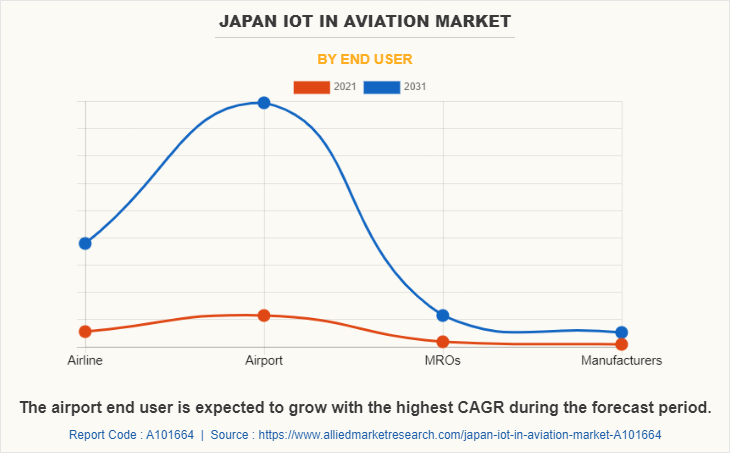The Japan Internet of Things (IoT) in aviation market has witnessed significant traction in the recent years. This traction is attributed to the digital revolution occurring in the aviation industry, with IoT playing a substantial role in it. The growth of the market is driven due to a range of factors. Key drivers include the need for efficiency, safety, and sustainability in the industry. Different end users such as airlines; airports; and Maintenance, Repair, and Overhaul providers (MROs) seek solutions which enhance their operations and reduce costs. In addition, IoT technology possesses the ability to provide real-time data and analytics, therefore augmenting the growth of the market.

However, there are certain restraints of the growth of the Japan Internet of Things (IoT) in aviation market. Security concerns, data privacy issues, and large investments required in the deployment of IoT are the key restraints of the market. In addition, lack of compliance with the stringent regulations implemented to avoid cyber-attacks hampers the development of the market.
On the contrary, various lucrative opportunities are expected to evolve the Japan Internet of Things (IoT) in aviation market. Applications such as ground operations, passenger experiences, and asset management have provided airlines the opportunity to optimize their routes, reduce fuel consumption, enhance customer experiences, improve security, as well as streamline passenger flows using IoT solutions. Furthermore, precise aircraft maintenance and efficient air traffic management demand integration of IoT technology, therefore opening new growth avenues for IoT providers.


Qualitative developments provide deep insights about the Japan Internet of Things (IoT) in aviation market. New product development is essential to meet the evolving needs of the aviation industry. In addition, constant R&D activities are required for companies to develop cutting-edge solutions which provide them with a competitive advantage. Furthermore, understanding end-user perceptions is crucial to provide passengers with an exceptional travel experience. IoT technologies aid in enhancing this experience. Moreover, flexible pricing strategies are adopted to ensure that IoT solutions are accessible to a broad range of aviation stakeholders.
By Application
The Passenger Experience type is expected to grow with the highest CAGR during the forecast period.
The Porter’s five forces analysis assists to understand the competitive scenario of the Japan Internet of Things (IoT) in aviation market and role of each stakeholder. The analysis includes threat of new entrants, threat of substitutes, bargaining power of buyers, bargaining power of suppliers, and competitive rivalry. The bargaining power of suppliers is substantial as they supply the necessary components of IoT technology, including hardware, software, and services. The bargaining power of buyers is significant as the presence of multiple providers ensures that they receive the best IoT solutions on favorable terms. The threat of new entrants is low as the aviation industry is a highly regulated space, which acts as a significant barrier to new entrants. The threat of substitutes is moderate as various alternative technologies and methods are available to the aviation industry. Competitive rivalry is intense in the market owing to numerous players striving to garner a large share of the market.
SWOT analysis offers an insightful perspective on the Japan Internet of Things (IoT) in aviation market, dissecting its strengths, weaknesses, opportunities, and threats. The strengths of the market include availability of real-time data & analytics and convergence of IoT & AI which offers predictive maintenance as well as enhanced safety. However, the weaknesses of the market are security & data privacy concerns posed due to adoption of IoT solutions, high cost of deploying IoT technology, and complexity of integrating IoT into existing aviation systems. On the contrary, the opportunities for the market include stringent regulations mandating the integration of IoT technology and increasing demand for innovative solutions in IoT. The threats for the market are intense competition & availability of alternative technologies and rapid technological advancements which render existing solutions obsolete.
Key players operating in the Japan Internet of Things (IoT) market are Mitsubishi Electric Corporation, NEC Corporation, Panasonic Corporation, NTT Data Corporation, Fujitsu Limited, Hitachi, Ltd., ANA Holdings Inc., Japan Airlines Co., Ltd., Omron Corporation, and Yokogawa Electric Corporation.
Key Benefits For Stakeholders
- Enable informed decision-making process and offer market analysis based on current market situation and estimated future trends.
- Analyze the key strategies adopted by major market players in Japan IoT in aviation market.
- Assess and rank the top factors that are expected to affect the growth of Japan IoT in aviation market.
- Top Player positioning provides a clear understanding of the present position of market players.
- Detailed analysis of the Japan IoT in aviation market segmentation assists to determine the prevailing market opportunities.
- Identify key investment pockets for various offerings in the market.
Japan IoT in Aviation Market Report Highlights
| Aspects | Details |
| Forecast period | 2021 - 2031 |
| Report Pages | 77 |
| By Component |
|
| By End User |
|
| By Application |
|
| Key Market Players | All Nippon Airways, Sumitomo Corporation, NEC Corporation, Hitachi, IHI Corporation, Fujitsu, Otani Electronics Systems, Japan Airlines, NTT Data Corporation, Mitsubishi Electric |
The Japan IoT in Aviation Market is estimated to reach $143.9 million by 2031
Japan Airlines, All Nippon Airways, Otani Electronics Systems, Hitachi, Mitsubishi Electric, Fujitsu, NEC Corporation, NTT Data Corporation, Sumitomo Corporation, IHI Corporation are the leading players in Japan IoT in Aviation Market
1. Enable informed decision-making process and offer market analysis based on current market situation and estimated future trends.
2. Analyze the key strategies adopted by major market players in japan iot in aviation market.
3. Assess and rank the top factors that are expected to affect the growth of japan iot in aviation market.
4. Top Player positioning provides a clear understanding of the present position of market players.
5. Detailed analysis of the japan iot in aviation market segmentation assists to determine the prevailing market opportunities.
6. Identify key investment pockets for various offerings in the market.
Japan IoT in Aviation Market is classified as by component, by end user, by application
Loading Table Of Content...
Loading Research Methodology...



